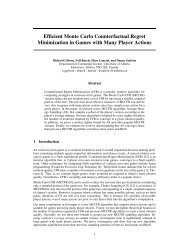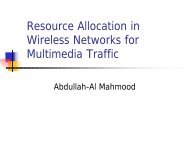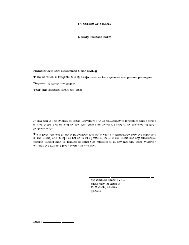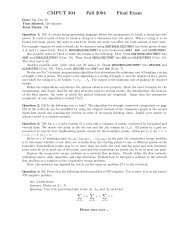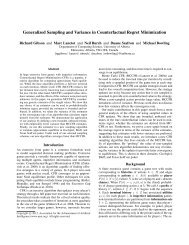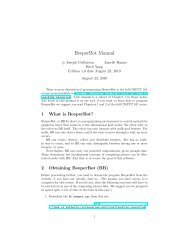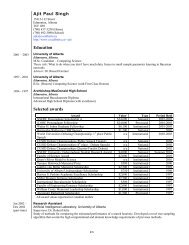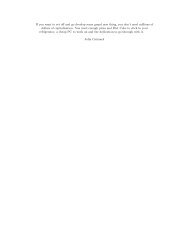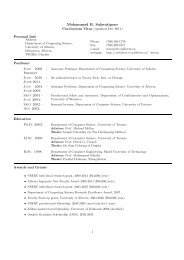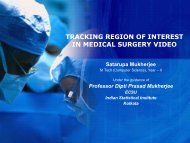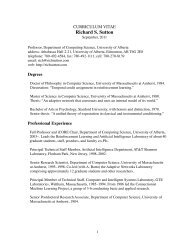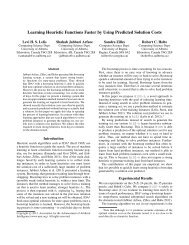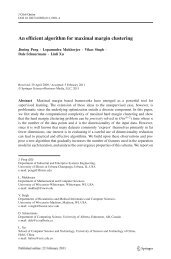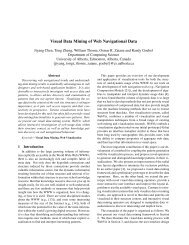Here - Webdocs Cs Ualberta
Here - Webdocs Cs Ualberta
Here - Webdocs Cs Ualberta
- No tags were found...
You also want an ePaper? Increase the reach of your titles
YUMPU automatically turns print PDFs into web optimized ePapers that Google loves.
University of Saskatchewan <br />
Proceedings of the Twelfth <br />
Annual <br />
Graduate Symposium <br />
on Computer Science <br />
April 11, 2000<br />
Department of Computer Science<br />
Saskatoon , Saskatchewan, Canada
A Generalized Cellular Texture Basis Function<br />
Xuejie Qin <br />
Department of Computer Science <br />
University of Saskatchewan <br />
57 Campus Drive <br />
Saskatoon, SK. S7N 5A9 <br />
Canada <br />
E-mail: xuq4l4 @cs.usaskca <br />
Supervisor: Dr. Herbert Yang <br />
Abstract<br />
Texture basis function plays a very important role in procedural texturing. In the literature,<br />
there are only two texture basis functions proposed, namely Perlin's noise and Worley's noise.<br />
In this paper, a new generalized cellular texture basis function is proposed. This new texture<br />
basis function is a generalization of Worley's noise. The proposed basis function can be used<br />
in procedural texturing algorithms to generate some interesting texture patterns, such as<br />
crumpled wrinkle, wood, marble, cloud, flame and cell-like patterns.<br />
1. Introduction<br />
Texturing, a process of generating textures on the surface of 3D objects, is an important and active research<br />
topic in the field ofcomputer graphics and image processing. In the literature, various texturing techniques have<br />
been proposed. All of these techniques can be classified into two categories: non-procedural and procedural.<br />
In non-procedural techniques, synthesized textures are generated after analyzing or mapping input textures.<br />
Some of the successful models include texture mapping [Blinn, 1976; Bunker, 1984; Dungan, 1978; Green,<br />
1986], and statistical and random models [Cross, 1983; Bonet, 1997; Heeger, 1995]. In procedural techniques,<br />
various procedures (algorithms) are developed to generate textures without requiring input textures. Textures<br />
are generated directly on the surface of 3D objects from calling a procedure. By defining different procedures,<br />
different kinds of textures can be generated. Some of the successful procedural techniques include shade tree<br />
[Cook, 1984], pixel stream editor [Perlin, 1985], reaction-diffusion system [Turk, 1991; Witkin, 1991], and a<br />
genetic texture-programming system [Sims, 1991].<br />
Compared with non-procedural techniques, procedural techniques are extremely fast, highly realistic and<br />
storage-efficient. Nonetheless, there are still some challenging problems unsolved or ill solved in those<br />
procedural techniques. One of the challenging problems is to define some well-behaved texture basis functions<br />
so that they can be called by texturing procedures in different ways to generate various kinds of textures. In the<br />
literature, there are only two basis functions proposed, namely Perlin's noise [Perlin, 1985] and Worley's noise<br />
[Worley, 1996].<br />
In this paper, a new generalized cellular texture basis function is proposed. This new basis function is a<br />
generalization of Worley's noise [Worley, 1996]. Worley's noise is a linear combination ofn i 'h closest feature<br />
point basis functions, whose values at a given point in the space are determined by that point and the feature<br />
points around that point. The proposed basis function extends the Worley's noise by including a non-linear<br />
combination of those i'h closest feature point basis functions. We found that using this generalized basis<br />
function will generate more interesting texture patterns than Worley's noise. In addition, this basis function can<br />
be used as a complement of Perlin's noise. Wood., marble, clouds and flame can be generated by using this new<br />
generalized basis function. In some cases, the textured images generated by the proposed basis function look<br />
153
Xuejie Qin<br />
more interesting and realistic than those generated by Perlin's noise. Experimental results are presented to show<br />
these facts.<br />
The remainder of this paper is organized as follows. The next section presents the literature review of previous<br />
works on texturing, focuses on procedural texturing. Section 3 presents the proposed generalized cellular texture<br />
basis function and the algorithm to compute this basis function. In section 4, we describe some applications of<br />
the proposed basis function in procedural texturing, and present some experimental results. Finally, conclusions<br />
are drawn in section 5.<br />
2. Previous Works on Texturing<br />
The work in this paper is closely related to texturing in the field of computer graphics. Texturing is a process of<br />
creating textures on the surface of 3D objects. The purpose of texturing is to add visual realism to computer<br />
synthetic images. Techniques for texturing can be classified into two categories: non-procedural and procedural.<br />
2.1 Non-Procedural Texturing<br />
In non-procedural approach, two different kinds of techniques may be used to generate synthesized textures:<br />
texture mapping techniques and texture analysis/synthesis techniques. With texture mapping techniques, input<br />
texture patterns are mathematically transferred first onto the surfaces of 3D models that are used to represent<br />
real world scenes. Then, the textured 3D surfaces are perspectively projected onto the output image viewing<br />
plane. Texture tiling [Dungan, 1978], cell texturing [Bunker, 1984], reflection mapping [Blinn, 1976] and<br />
environment mapping [Green, 1986] are some of the specific names to describe variations of the texture<br />
mapping techniques.<br />
With texture analysis and synthesis techniques, an input texture patch is first analyzed, then texture information<br />
is characterized by a set of parameters, and finally the synthesized texture is generated based on those<br />
parameters. Some of the successful texture analysis and synthesis models include Markov Random Field texture<br />
models [Cross, 1983], multiresolution sampling procedure [Bonet, 1997] and pyramid-based texture analysis<br />
and synthesis [Heeger, 1995].<br />
2.2 Procedural texturing<br />
Procedural texturing has been proven to be a powerful approach to add visual detail to the surface of rendered<br />
objects in image synthesis. In this approach, textures are generated directly on the surface of 3D objects from<br />
calling a procedure, which may call other procedures. By defining different procedures, different kinds of<br />
textures can be generated. .<br />
Since the middle of 1980s, procedural techniques for generating realistic textures, such as marble, wood, stone,<br />
water, smoke, clouds, flame and other natural materials have gained widespread use in the field of computer<br />
graphics. Some useful procedural texturing techniques are summarized below. For a complete discussion of the<br />
procedural texturing techniques, we refer the readers to [Ebert, 1998].<br />
Cook in [Cook, 1984] described a system called shade trees, which was one of the first systems in which it was<br />
convenient to generate procedural textures during rendering. Shade trees enable the use of different treestructured<br />
shading models for different surfaces such as copper, wood, grass, and etc. The input parameters to<br />
the shading models, called appearance parameters, can be manipulated procedurally. In this way, shade trees<br />
make it possible to use textures to control any part of the shading calculation. Color and transparency textures,<br />
reflection mapping, bump mapping, displacement mapping and solid texturing can all be implemented using<br />
shade trees.<br />
Perlin in [Perlin, 1985] described a complete procedural texture generation language (Pixel Stream Editor) and<br />
laid the foundation for the most popular class of procedural textures in use today, in particular those based on<br />
noise, a stochastic texture generation basis function. By using his noise basis function, Perlin has generated very<br />
convincing representations of clouds, fire, water, stars, marble, wood, rock, soap films, and crystal.<br />
154
A Generalized Cellular Texture Basis Function<br />
Turk in (Turk, 1991] and Witkin in (Witkin, 1991] described synthesis texture models inspired by reactiondiffusion.<br />
Reaction-diffusion is a process in which two or more chemicals diffuse at unequal rates over a surface<br />
and react with one another to form stable patterns such as spots and strips in the skins of animals.<br />
Sims in (Sims, 1991] describes an interactive system to apply evolutionary techniques of variation and selection<br />
to create complex simulated structures, textures, and motions for use in computer graphics and animation. In his<br />
system, procedural textures are represented as LISP expressions. By interactively selecting among the resulting<br />
textures, the user of the system can direct the simulated evolution of a texture in some desired direction.<br />
Worley in (Worley, 1996] proposed a cellular texture basis function, called Worley's noise, which can be used<br />
as solid texturing primitive to generate textured surfaces resembling flagstone-like tiled areas, organic crusty<br />
skin, crumpled paper, ice, rock, mountain ranges, and craters. Worley's noise is a linear combination of n if"<br />
closest feature point basis functions, whose values at a given point in the space are the distances from the point<br />
to the feature points around that point.<br />
2.3 Non-Procedural Texturing versus Procedural Texturing<br />
Since the non-procedural texturing depends on input texture, the synthesized texture can be predicted and<br />
controlled as expected, while on the other hand, the synthesized texture is at most as good as the input texture.<br />
In addition, each model may only handle some specific kinds of textures, and may not work for other kinds of<br />
textures.<br />
Compared with non-procedural techniques, procedural techniques have the advantages of extremely fast, high<br />
quality of realism and storage efficiency. Nonetheless, procedural approach has its own disadvantages. In<br />
general, it is difficult to develop a texturing procedure; there is no general procedure for all or at least some<br />
kinds of textures; and the resulting texture is difficult to predict and measure with a set of parameters.<br />
3. The Generalized Cellular Texture Basis Function (GCTBF)<br />
Texture basis function plays a very important role in procedural texturing. It can be used as a solid texturing<br />
primitive for building different kinds of textures in various texturing procedures. Unfortunately, there are only<br />
two texture basis functions proposed in the literate, namely Perlin's noise (Perlin, 1985] and Worley's noise<br />
Worley [Worley, 1996]. In this section, a new generalized cellular texture basis function is first formularized,<br />
and then the algorithm to compute this basis function is given.<br />
3.1 Mathematical Formulation<br />
The generalized cellular texture basis function, denoted by GCTBF, is a scalar function whose domain is the<br />
whole 3D space and its range is the set of non-negative real numbers, i.e . . GCTBF: 9\3 ~ 9\+ u {O}. For a<br />
given point x in 9\3, GCTBF(x) is defined as:<br />
GCTBF(x) =GCTBF(F; ,F 2<br />
, •••,FJ(x) =~>;F;(x) + '~>ij1\(x)Fj(x) (1)<br />
i=-l<br />
i,)=1<br />
where n, C;, Clf are constants known as priors for i,j = 1,2,3, ... , n .<br />
In the above formula, the function 1\ is called the if" closest feature point basis function, whose value at x<br />
measures the distance from x to the t" closest feature point around x. For example, F.. (x) measures the<br />
distance from x to the first closest feature point, F; (x) measures the distance from x to the second closest<br />
feature point, and so on. It is easy to see that 1\ is a continuous function of x, and that F.. ::; F..+I<br />
for<br />
i = 1, 2, ... , n . The feature points around x are generated by a stochastic distribution function, such as Poisson<br />
155
Xuejie Qin<br />
distribution, Gamma-type distribution. We will discuss in more detail on how to generate the feature points<br />
around x in next subsection.<br />
If we let cij =0 in (1), then GCTBF(x) =!c,F,(x), this is the Worley's basis function (Worley's noise)<br />
;::1<br />
[Worley, 1996], which is a linear combination of F;, F 2' .•. , Fn' This implies that the proposed new texture<br />
basis function is a generalization of Woley's basis function, since GCTBF(x) includes a non-linear<br />
combination of F;Fj for i, j = 1,2, ... , n. Mathematically, the non-linear term F,F has more complex<br />
J<br />
behaviour than the linear term F;. Thus, using this new generalized basis function may generate more<br />
interesting texture patterns. In other words, the set of texture patterns generated by the new generalized basis<br />
function is a superset of the set of texture patterns generated by using Worley's basis function. Experimental<br />
results are presented in section 4 to show this fact.<br />
In the formula (1), the coefficients c, ,cyare known as priors. Theoretically, they can be any value of a real<br />
number. In the actual implementation of this basis function in this paper, we leave the task of setting values for<br />
cpcy to the texturing procedures that call this basis function. For computation efficiency reason, we restrict the<br />
value of n in (1) up to 4.<br />
3.2 Algorithm to Compute GCfBF<br />
From (1) in the previous section, for a given point x in the space, the value of GCTBF at x is easy to<br />
calculate if we know the value of F, at x for i = 1, 2, ... n . By definition, F, (x) is the distance from x to the<br />
i'h closest feature point around x . If we could locate all the feature points around x , then it is easy to calculate<br />
F;(x) . In this subsection, we first present the general algorithm, then the detailed algorithm to compute F;(x) .<br />
3.2.1 General Algorithm to Compute F;(x)<br />
As in [Worley, 1996], we generate the feature points around x by using Poisson distribution function. By this<br />
distribution function, the probability of m feature points occurring in a unit cube is given by the following<br />
formula:<br />
where A measures the mean density of feature points per unit cube, which is known as a prior, say A=4 .<br />
Using formula (3) , we pre-compute the values of p(m) for m =0,1,2, ... , M , where M is the maximum<br />
number of feature points known as a prior, for example M =50. Then, we store the values of p(m) in a<br />
distribution look-up table.<br />
F or each point x in 9\ J , we use a unit cube to surround x. The base of the unit cube, which is defined as the<br />
coordinates of the bottom-left-front vertex of the cube, is equal to the integer part of the coordinates of x. <strong>Here</strong><br />
we assume a left-handed coordinate system. We use the base of the unit cube to define a seed to initialize a fast<br />
random number generator. We generate a random number r using the already initialized random number<br />
generator, and look up r in the distribution look-up table. The value of m such that the corresponding p(m) is<br />
the closest one to r will be the number offeature points required in the unit cube surrounding x .<br />
After the number of feature points is calculated, the location of feature points must be calculated by using the<br />
same initialized random number generator; this is crucial to ensure that the algorithm works correctly to<br />
compute F;(x) . In fact, the coordinates of each feature point in the cube can be computed by calling the same<br />
initialized random number generator three times. With the locations of all feature points in the cube computed,<br />
(3)<br />
156
A Generalized Cellular Texture Basis Function<br />
the calculation of the distances from those feature points to x is easy . To get F, (x), F2 (x), ... , Fn (x) , we just<br />
sort the distances into increasing order.<br />
The algorithm should not stop at this point. Since the distance from a feature point to x may reach .J3 in the<br />
extreme case, a feature point in the neighboring cube may even be closer 10 x than those already computed.<br />
Thus the algorithm should keep going to process the other 26 neighbonng cubes. For each of the neighboring<br />
cubes, the algorithm just repeats the same steps described before to compute the number and the locations of<br />
feature points but using a different seed for the random number generator based on that cube. The distances<br />
from the feature points to x are then computed, and the list of F,(x). F(x). .. .. F.(x) is finally updated using a<br />
simple sorting algorithm. Figure 1 shows in three neighboring cubes the relationship between the point x, the<br />
feature points, and F,(x), F 2 (x), .. . , Fn(x) around x with n = 4.<br />
Figure 1: The relationship between the point x, the feature points, and F,(x) in the three neighboring<br />
cubes around x for i =1, 2, 3, 4 . The point x is represented by a red dot; the feature points are<br />
represented by green dots.<br />
3.2.2 Detailed Algorithm to Compute F,(x)<br />
For a given point x in the space, we use six steps to compute F, (x). The ftrst step is the initializations of the<br />
distribution look-up table and the permutation table that will be used in later steps. These two tables are precomputed<br />
only once and stored as arrays. The steps from two to six are the main parts of the algorithm used to<br />
compute F,(x) for i = 1,2,oo.,n . In this algorithm, we assume that a left-handed coordinate system is used. The<br />
detailed algorithm is given as follows.<br />
1. Initialization and pre-computation.<br />
• Pre-compute the values of p(m) , for m=0,1,2, oo., M, where p(m)=;{m/(m! e)' ) , .,1,=4, and<br />
M =50. Store them as a Possion distribution look-up table. Name it as DistributionTable[M].<br />
• Pre-compute a permutation array of size 2 16 , each element of the array is a random number between °<br />
and 2 16 -1 inclusively. Name it as PermutationTable[N] , where N =2 16 •<br />
2. For each point x =(xl'x2'x 3<br />
) in the space, defme a unit cube C x<br />
containing x. The base of C x<br />
is<br />
computed by base(CJ = (jloor(xi ),jloor(x 2 ),jloor(x))). For example, if x =(1.1,2.3,3.4), then<br />
base(CJ=(1,2,3) .<br />
3. Compute the number of feature points in cube C x<br />
using the pre-computed Possion distribution look-up<br />
table.<br />
• Compute a seed s for a fast random number generator using the pre-computed permutation table.<br />
157
Xuejie Qin<br />
(1) TABMASK = 2 16 -l.<br />
(2) PERM(x) =PermutationTable[x & TABMASK] , where & is the bitwise and operator.<br />
(3) INDEX(xPX2'X]) = PERM(XI +PERM(x2+PERM(xJ)).<br />
(4) XI = xcomp(base(ex )), x 2 = ycomp(base(e, )), x] = zcomp(base(e,))<br />
(5) s =INDEX(xp x2, x])<br />
• Initialize a random number generator using seed s.<br />
• Generate the first random number r using the above initialized random number generator.<br />
• Look up r in the table DistributionTable[M] . The value of m, such that p(m) is the closest one to<br />
r in DistributionTable[M] is the number offeature points required in ex' Return the value of m .<br />
4. Compute the location of the m feature points in the cube ex' For each of the feature points, compute its<br />
xyz coordinates using the already initialized random number generator. These coordinates are relative to<br />
the base of ex'<br />
5. For each of the feature points, compute its distance to x, keep a sorted list of the n smallest distances<br />
F.. (x), F2 (x), ... , Fn (x) , where n is known as a prior, for example n = 4.<br />
6. For each of the 26 neighboring cubes of ex' repeat step 2 to step 5, and update the list of<br />
F.. (x), F2 (x), ... , Fn (x) at the end of step 5.<br />
4. Applications in Procedural Texturing Using GCTBF<br />
The new proposed cellular texture basis function can be used as a solid texturing primitive for building various<br />
kinds of textures in procedural texturing. As with Perlin's noise, mapping the value of this basis function at a<br />
surface point into a color and normal-displacement can provide visually interesting and impressive effects.<br />
Combining color or bump mapping with fractal technique, a variety of texturing procedures can be implemented<br />
based on this new basis function to generate wrinkle, wood, marble, cloud, terrain, and flame-like textures. In<br />
this paper, the texturing procedures are implemented using RenderMan Shading Language (SL). We also<br />
implement the new basis function in C++ and link them as dynamic shared objects (DSO) so that we can call it<br />
as a SL built-in function in surface or displacement shaders written in Shading Language. In the rest of this<br />
section, some applications using this basis function in procedural texturing are described, and experimental<br />
results are presented.<br />
4.1 Using GCfBF in Color Mapping<br />
Color mapping is used to map a number into a color. The commonly used color mappings are the spline<br />
function and the mix function. The value of mix(c p c 2 ,t) at t is equal to (l-t)*c 1<br />
+t*c2 with tE [0,1],<br />
where C I ,C 2<br />
are colors known as priors. To map a surface point to a color, we can first use GeTBF to map that<br />
surface point into a number, then use a color mapping to map that number into a color. For example, for a given<br />
point x on the surface of a 3D synthetic object, the color at x, denoted pattern(x), can be determined by the<br />
formula:<br />
pattem(x) =color spline(clamp(GeTBF(x),0,1),c p c2, ... ,cJ (4)<br />
In the above formula, c P<br />
c 2 , ... ,c n are given colors. The function clamp(s,a,b) returns a if s is less than a, b<br />
if s is greater than b; otherwise it returns s. To obtain different texture patterns, we can use different values<br />
for n and define different color values for c p c2""'c n , Note that some C; s may have the same value. For<br />
example, if we let n = l3, and c = c = c = c = C = (0.25,0.25,0.35), c] = c. = C = (0.1 0, 0.1 0, 0.30),<br />
i 2 6 7 l2 s<br />
C s = c 9<br />
=(0.05,0.05,0.26), CIO =C II<br />
= CIJ = (0.03,0.03,0.20), then we can generate blue-marble-like patterns on<br />
158
A Generalized Cellular Texture Basis Function<br />
the surface ofobjects. As a color mapping, the mix function can be used in a similar way as spline function. An<br />
example ofusing mix can be found in example 2 in section 4.3.<br />
Figure 2 shows some patterns generated using (4) with n = 13, and the values of c p<br />
c 2<br />
,,,,,c n<br />
are given as<br />
before. To compare, we present the corresponding pattern generated by Perlin's noise. Figure 2 also shows that<br />
patterns generated using non-linear combinations of F; are more interesting than patterns generated by linear<br />
combination of F; for i = 1,2, ... , n .<br />
4.2 Using GCfBFin Bump Mapping<br />
Bump mapping technique was first introduced by Blinn in [Blinn, 1978]. This technique involves <br />
modifYing the surface normal vectors to give the appearance that the surface has bumps or indentations. As <br />
with Perlin's noise, the new basis function can also be used in bump mapping to create bumps on the <br />
surface of synthetic objects. For a given point x on the surface, the normal N at x can be modified using <br />
an algorithm like this: <br />
bump(x) = abs(0.5 - GCTBF(kx» <br />
x =x - bump(x) *normalize(N)<br />
N = calculationnormal(x) <br />
(5) <br />
Figure 3 shows an example of creating bumps using (5) with k =3 (the last four images). To compare, we<br />
also present the original image without bumps (the first image), and the one with bumps generated by<br />
Perlin's noise (the second image).<br />
43 Using GCfBFin Fractal<br />
Fractal technique offers a very easy way to generate geometrically complex objects like crumpled wrinkle,<br />
cloud, flame, water and terrain. The complexity arises simply through the repetition of form over some range of<br />
scale. Mathematically, we get a simple fractal when we take a basis function, scale it down, and add it again to<br />
the same function. For example, if we let sin(p) be a basis function of p, then !(P) = ! (sin(l'p) / n is a<br />
i=O<br />
fractal of p based on sin(p). In the expression, n is called octaves, which tells exactly how many times we<br />
should scale and add the basis function into itself; and I is called lacunarity, which tells how much we should<br />
scale the basis function for each octave, a typical value for I is 2. The composite of two fractal functions or a<br />
fractal with a simple function is also a fractal. For a complete discussion of fractal, the reader is referred to<br />
[Ebert, 1998].<br />
Combining fractal with color mapping or bump mapping when using GCTBF in procedural texturing, we can<br />
generate even more interesting textures such as crumpled wrinkle, cloud, flame, water, and terrain. In the rest of<br />
this subsection, we present two examples to demonstrate how to combine fractal with color or bump mapping<br />
when using GCTBF as a solid texturing primitive.<br />
Example 1: Combining fractal with bump mapping to generate crumpled wrinkles. To create crumpled<br />
. wrinkles on a surface, we can use a fractal version ofbump mapping in the algorithm described in (5), which is<br />
given in (6) below. Figure 4 shows some images generated using (6) with GCTBF = F; - F.. - F..F.. and<br />
octaves = 0,1,2,3,4 respectively.<br />
159
Xuejie Qin<br />
fractal(x) =ocfsabs(0.5 - GCTBF(2; x))/ 2;<br />
;=0<br />
bump(x) =fractal(x) * fractal(x) *fractal(x)<br />
x =x -bump(x)*normalize(N) <br />
N =calculationnormal(x) <br />
(6) <br />
Example 2: Combining fractal with color mapping to generate cloud. For a given point x on a surface, the<br />
cloud-like pattern, denoted cloud Pattern (x) , can be given by the following algorithm:<br />
skycolor =(0.15,0.15,0.60)<br />
coludcolor =(1.00,1.00,1.00)<br />
oclo\'t!S 1 .<br />
(7)<br />
fractal(x) = L --;-((1- 2 *GCTBF(2' x)) *smoothscale(2; x))<br />
1=0 2<br />
coludPattern(x) =mix(skycolor, cloudcolor,smmothstep(O, 1, fractal(x)))<br />
In the above c10ud-1ike-pattern-generating algorithm, the function smoothscale(p) has a complex form and its<br />
value at the point p depends on the differential surface area at p. For more information on this function, we<br />
refer the reader to chapters 10-13 in the book [Ebert, 1998]. The mix function is the actual color mapping used<br />
in this algorithm, whose definition is given in section 4.1. The smoothstep(min,max,t) function returns 0 if t<br />
is less than min, 1 if t is greater than or equal to max, and performs a smooth Hermite interpolation between 0<br />
and 1 in the interval min to max. Figure 5 shows some cloud patterns generated using the algorithm described in<br />
(7) . To compare, we also present the corresponding cloud pattern generated by Perlin's noise in Figure 5.<br />
Before we end this subsection, we give three synthetic images textured by using GCTBF, as shown in Figure 6.<br />
Figure 6(a) shows a scene with a vase placed on a wooden table under a cloudy sky. The marble-like patterns on<br />
the vase, the wood patterns on the table and the clouds in the sky are generated by three different texturing<br />
procedures (surface shaders written in RenderMan Shading Language) that call GCTBF. Precisely, the marblelike<br />
pattern, the wood pattern and the cloud pattern used in the scene are generated by<br />
4 4<br />
I(-l);F, + I (-IY+) F,F) , F; -FIF;, and F;F2 +F2F) respectively. Figure 6(b) shows a scene with a tree<br />
;=1 i,)=1<br />
trunk placed on a rocky ground under a cloudy sky. The wood pattern on the tree trunk and the cloud pattern in<br />
the sky are generated by F) - FJF J and F; respectively. The rocky ground is generated by the technique<br />
described in (6) of example 1 with GCTBF = F2 - F; - F;F; and octaves = 4. Figure 6(c) shows a simple<br />
scene of flame. This scene is rendered using a single patch textured by a flame-texturing procedure that calls<br />
GCTBF with GCTBF(x) =F; (x) . This flame-like texture is actually generated by combining fractal technique<br />
with spline color mapping.<br />
5. Conclusion<br />
Texture basis function plays an important role in procedural texturing. In the literature there are only a couple of<br />
texture basis functions proposed, namely Perlin's noise and Worley's noise. In this paper, a new generalized<br />
cellular texture basis function, called GCTBF, is proposed. This basis function is a generalization of Worley's<br />
noise. Worley's noise is a linear combination of n it' closest feature point basis functions, whose values at a<br />
given point in the space are the distances from that point to the feature points. The new basis function extends<br />
Worley's noise by including a non-linear combination of those it' closest feature point basis functions.<br />
Mathematically, the non-linear terms have more complex behaviors than the linear terms. Experimental results<br />
have also demonstrated this fact.<br />
The new basis function Can be used as a solid texturing primitive for building various kinds of textures in<br />
procedural texturing. There are three ways in using GCTBF in the application of procedural texturing: color<br />
160
A Generalized Cellular Texture Basis Function<br />
mapping, bump mapping and fractal. By combining color or bump mapping with fractal technique, a variety of<br />
texturing procedures can be implemented based on this new basis function to generate crumpled wrinkle, wood,<br />
marble, cloud, water and flame-like textures.<br />
Reference<br />
[Blinn, 1976] J.F. Blinn and M.E. Newell. Texture and Reflection in Computer Generated Images. CACM 19, lO(May), <br />
pp.542-547. <br />
[Blinn, 1978] J.F. Blinn. Simulation of wrinkled surface. Computer Graphics, 12(3), pp.286-292, July 1978. <br />
[Bonet, 1997] J.S. Bonet. Multiresolution Sampling Procedure for Analysis and Synthesis of Texture Images. Computer <br />
Graphics, pp.361-368, 1997. <br />
[Bunker, 1984] M. Bunker, R. Economy and J. Harvey. Cell texture - Its Impact on Computer Image Generation. In <br />
Proceedings of the Sixth Interservice.lIndustrial Association, Washington, DC, ppI49-155, October 1984. <br />
[Cook, 1984] R.L. Cook. Shade Tress. Computer Graphics, 18(3), pp.223-231, July 1984. <br />
[Cross, 1983] G.c. Cross and A.K. Jain. Markov Random Field Texture Models. IEEE Transactions on Pattern Analysis <br />
and Machine Intelligence 5, pp25-39, 1983. <br />
[Dungan, 1978] W. Dungan, A. Stenger and G. Sutty. Texture Tile Considerations for Raster Graphics. Computer Graphics, <br />
12(3), pp.130-134, August 1978. <br />
[Ebert, 1998] D.S. Ebert, F.K. Musgrave, K.P. Peachey, K. Perlin and S. Worley. Texturing and Modeling: A Procedural <br />
Approach. Academic Press, 1998. <br />
[Francos, 1993] J.M. Francos, A.Z. Meriri and B. Porat. A Unified Texture Model Based on a 2D Wold-Like <br />
Decomposition. IEEE Transactions on Signal Processing 41, pp.2665-2678, 1993. <br />
[Green, 1986] N. Green. Environment Mapping and Other Applications of Worid Projection. IEEE Computer Graphics <br />
Application, Nov. pp.21-29, 1986. <br />
[Heeger, 1995] AJ . Heeger and J.R. Bergen. Pyramid-Based Texture Analysis/Synthesis. Computer Graphics, pp.229-238, <br />
1995. <br />
[Lewis, 1984] J.P. Lewis. Texture Synthesis for Digital Painting. Computer Graphics, 18(3), pp.245-252, 1984. <br />
[Perlin, 1985] K.Perlin. An Image Synthesizer. Computer Graphics, 19(3), pp.187-296, July 1985. <br />
[Pixar, 1989] Pixar. The RenderMan Interface: Version 3.1. Pixar, San Rafael, California, 1989. <br />
[Rao, 1990] A.R. Rao. A Taxonomy for Texture Description and Identification. Randing, Springer-Verlag, 1990. <br />
[Schachter, 1979] BJ. Schachter and N. Ahuia. Random Pattern Generation Processes. Computer Graphics and Image <br />
Processing, 10, pp.95-114, 1979. <br />
[Sims, 1991] K. Sims. Artificial Evolution for Computer Graphics. Computer Graphics, 25(4), pp. 319-328, July 1991. <br />
[Turk, 1991] G. Turk. Generating Textures for Arbitrary Surfaces Using Reaction-Diffusion. Computer Graphics, 25(3), <br />
pp.289-298, July 1991. <br />
[Witkin, 1991] A. Witkin and M.Kass. Reaction-Diffusion Textures. Computer Graphics, 25(3), pp.299-308, July 1991. <br />
[Worley, 1996] S. Worley. A Cellular Texture Basis Function. Computer Graphics, pp.291-294, July 1996. <br />
Acknowledgment<br />
I would like to thank Dr. Herbert Yang for his patient supervision of this paper.<br />
161
Xuejie Qin<br />
,,' ,<br />
- ~ & F ~<br />
,- "<br />
"1 ~ \ ""<br />
'. "... ., ,;.. .<br />
: !>" '" ,...<br />
Perlin Pi F z - FIPi FzF z - FIPi F, • F! - F,F 4 F3F3 + F3F, - F,F,<br />
Figure 2: An example of using GCTBF in color mapping. The first pattern is generated by Perlin's<br />
noise; the rest ofthem are generated by GCTBF with five different combmatlons shown above.<br />
Original Perlin Pi F 2 F z - FIF2 F, • Fl - FIFI F,F, - F3F3 + F2F2 - PiFI<br />
Figure 3: An example of creating bumps using GCTBF (the last four) The first is the original image<br />
without bumps; the second is the one with bumps generated by Perlin' s noise.<br />
Original octaves =0 octaves = 1 octaves = 2 octaves =3 octaves=4<br />
Figure 4: Sample images generated by using algorithm described in (6) with GCTBF =F2 - F; - F; F; .<br />
From left to right, the values of octaves used are 0, 1,2,3, and 4. The first is the original image.<br />
Perlin Pi PiF2 PiFz + F2F3 F2 - FI + PiPi Pi + F, + F2F3 - F,F,<br />
Figure 5: Sample cloud patterns (the last five) generated using the algorithm described in (7) using<br />
GCTBF with five different combinations shown above. The first pattern is generated by Perlin's noise.<br />
(a) (b) (c)<br />
Figure 6: An example of textured images using GCTBF<br />
162
Xuejie Qin<br />
Perlin Fj F2 - FjFj F2F2 - FjFj F, • F, - F.F. FJFJ + FJF4 - F4F.<br />
Figure 2: An example of using GCTBF in color mapping. The first pattern is generated by Perlin's<br />
noise; the rest ofthem are generated by GCTBF with five different combmatlons shown above.<br />
Original Perlin Fj F2F2 - FjF2 F, • Fl - F,Fj F.F 4 - FJF J + F2F2 - FjFj<br />
Figure 3: An example of creating bumps using GCTBF (the last four) The first is the original image<br />
without bumps; the second is the one with bumps generated by Perhn· s nOise.<br />
Original oClaves=O oclaves= 1 octaves = 2 octaves = 3 oclaves=4<br />
Figure 4: Sample images generated by using algorithm described in (6) with GCTBF = F2 - F, - F,F, .<br />
From left to right, the values of octaves used are 0, I, 2, 3, and 4. The first is the original image.<br />
Perlin Fj FjF2 FjF2 + F2FJ F2 - Fj + FjFj Fj + F. + F2FJ - F.F.<br />
Figure 5: Sample cloud patterns (the last five) generated using the algorithm described in (7) using<br />
GCTBF with five different combinations shown above. The first pattern is generated by Perlin's noise.<br />
(a) (b) (c)<br />
Figure 6: An example of textured images using GCTBF<br />
162



